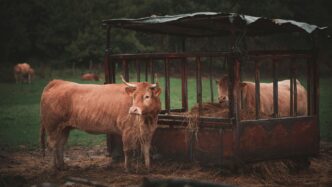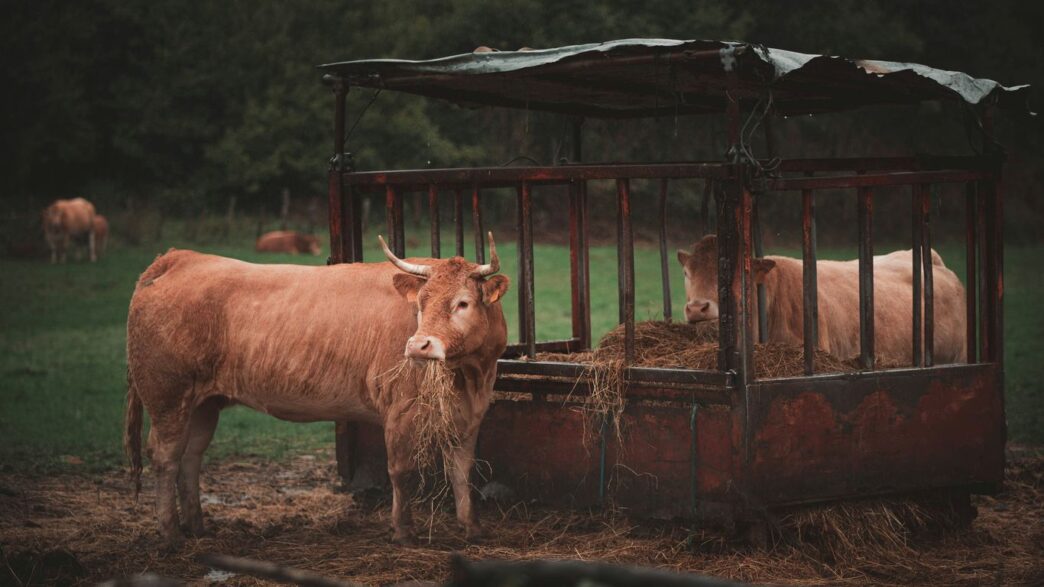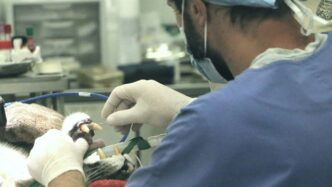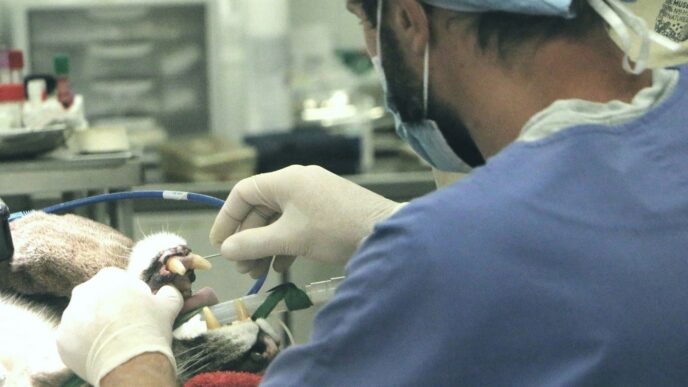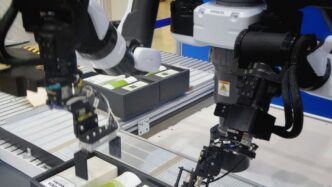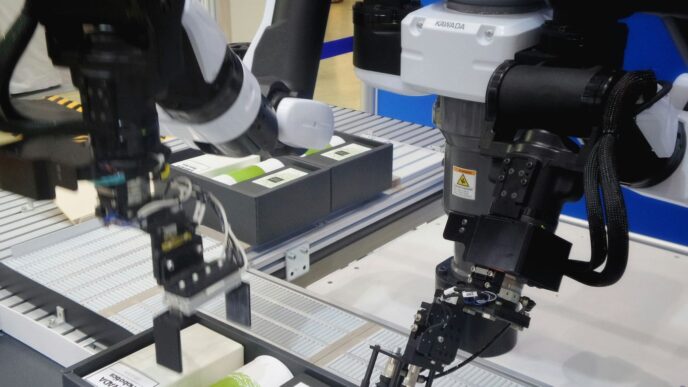Farming is changing, and fast. It’s not just about plows and tractors anymore. We’re seeing some really cool new tools and ideas pop up that are making farms work better and smarter. These new livestock technologies are helping farmers raise animals more efficiently and keep them healthier, all while trying to be kinder to the planet. Let’s take a look at some of the biggest shifts happening right now.
Key Takeaways
- New sensors and AI help farmers keep a close eye on animal health, spotting problems early before they get serious.
- Smart farming systems use data to figure out the best way to feed and water animals, cutting down on waste.
- Robots are starting to do some of the heavy lifting, like milking cows and delivering feed, freeing up farmers’ time.
- Science is finding ways to make animals more resistant to diseases and better suited to their environment through genetics.
- Connecting everything on the farm with the Internet of Things (IoT) and analyzing all that data helps farmers make better choices.
Advancements in Livestock Monitoring and Health

Keeping tabs on our farm animals has gotten a whole lot smarter lately. It’s not just about knowing if they’re eating; we’re talking about really understanding their well-being on a whole new level. These new technologies are changing how we care for livestock, making things better for the animals and for us farmers.
Artificial Intelligence for Animal Welfare
Artificial intelligence, or AI, is starting to play a big role in making sure animals are happy and healthy. Think of it like having a super-observant assistant who never gets tired. AI systems can watch herds, analyze their behavior, and flag anything that seems off. This could be anything from an animal showing signs of stress to not interacting with the group as usual. By spotting these subtle changes early, farmers can step in before a small issue becomes a big problem. It’s all about proactive care, moving beyond just reacting when something’s clearly wrong.
Sensor-Based Health Detection
Sensors are becoming incredibly common on farms, and they’re not just for tracking temperature or humidity anymore. We’re seeing sensors that can be attached to animals, or placed in their environment, to gather all sorts of health data. These might monitor things like an animal’s temperature, heart rate, or even its movement patterns. When you collect this kind of information continuously, you can start to see trends. For example, a slight rise in body temperature or a change in how much an animal is moving could be early indicators of illness. This data is then sent to a central system where it can be analyzed, often with the help of AI, to alert farmers to potential health concerns.
Automated Lameness Detection in Cattle
Lameness, or lameness, is a common and painful issue for cattle, and it can really impact their productivity and overall health. Traditionally, spotting a lame cow meant a farmer had to visually inspect each animal, which is time-consuming and can be difficult, especially in large herds. Now, AI-powered systems are being developed that use cameras and sophisticated algorithms to automatically detect lameness. These systems can analyze how a cow walks and stands, identifying subtle gait abnormalities that might be missed by the human eye. This means quicker identification and treatment for affected animals, leading to better recovery rates and improved welfare for the herd.
Precision Livestock Farming Technologies
Precision livestock farming is all about using technology to manage your animals and resources more smartly. Instead of just guessing, you’re using real data to make better decisions. This approach helps boost efficiency, improve animal health, and ultimately, increase your farm’s profitability. It’s like giving your farm a high-tech upgrade.
Data-Driven Resource Management
This part is about making sure every bit of feed, water, and space is used just right. Think about it: if you know exactly how much each animal needs, you’re not wasting anything. This means less money spent on feed and less waste overall. We’re talking about using sensors and smart systems to track things like water intake and feed consumption for individual animals or groups. This information helps you spot problems early, like an animal that’s not eating or drinking as much as it should, which could be a sign of illness.
Here’s a quick look at what we’re tracking:
- Feed Intake: Monitoring how much each animal eats to ensure optimal growth and health.
- Water Consumption: Checking water levels and usage to prevent dehydration and identify potential issues.
- Environmental Conditions: Keeping tabs on temperature, humidity, and air quality in barns.
- Activity Levels: Using sensors to see how much animals are moving, which can indicate health or stress.
Optimizing Feed and Water Systems
Getting the feed and water just right is a big deal for healthy animals. Precision farming tools can automate and fine-tune these systems. For instance, automated feeders can dispense the exact amount of feed needed at specific times, tailored to the age, weight, and production stage of the animals. This prevents overfeeding or underfeeding, which can lead to health problems or reduced productivity. Similarly, smart waterers can ensure a constant supply of fresh water and alert you if there’s a problem, like a blockage or a leak. Some systems can even adjust water temperature based on the weather.
Yield Monitoring and Analysis
While ‘yield’ might sound more like crop farming, in livestock, it translates to things like milk production, weight gain, and reproductive success. Precision livestock farming uses data to track these ‘yields’ more accurately. For example, automated milking systems record milk volume and quality for each cow. Sensors can track weight gain over time. Reproductive monitoring systems can help identify the best times for insemination. By analyzing this data, farmers can understand which animals are performing best, identify bottlenecks in production, and make informed decisions about breeding, feeding, and management strategies to improve overall farm output. It’s about understanding the performance of your herd at a granular level.
Robotics and Automation in Animal Husbandry
Robots and automated systems are really starting to change how we manage livestock. It’s not just about making things easier for farmers, though that’s a big part of it. These technologies are helping us be more precise, improve animal well-being, and even get more done with fewer resources. Think about tasks that are repetitive, physically demanding, or require a level of accuracy that’s hard for humans to maintain over long periods. That’s where robots are stepping in.
Automated Milking Systems
Automated milking systems, often called robotic milking, have become quite common in dairy operations. These systems allow cows to choose when they want to be milked. A robot arm guides the milking equipment to the cow’s udder, cleans it, attaches the cups, and then detaches them when milking is complete. The system also collects data on milk production, quality, and even cow health indicators like temperature and conductivity. This means cows aren’t stressed by fixed milking schedules, and farmers get a lot more detailed information about each animal.
- Improved Cow Comfort: Cows can be milked on their own schedule, reducing stress.
- Data Collection: Each milking session provides valuable data on milk yield, quality, and cow health.
- Labor Savings: Reduces the need for manual labor during milking.
- Hygiene: Automated cleaning and attachment processes can improve udder health.
Robotic Feeding Solutions
Feeding livestock is another area where robots are making a big impact. Automated feeding systems can dispense feed precisely, at the right times, and in the correct amounts for different groups of animals. This is especially useful in large operations or where specific dietary needs must be met. Some systems can even mix custom feed rations on-site. For example, a specialized robot has been developed for feeding rabbits, demonstrating high accuracy in navigation and precise feed delivery. This level of control helps reduce feed waste and ensures animals get the nutrition they need for optimal growth and health.
| Feature | Benefit |
|---|---|
| Precision Dispensing | Reduces feed waste, ensures correct portions |
| Timed Feeding | Supports animal digestion and health |
| Custom Ration Mixing | Meets specific dietary requirements |
| Reduced Labor | Frees up farm staff for other tasks |
Autonomous Livestock Management
Beyond milking and feeding, we’re seeing the beginnings of more autonomous systems for overall livestock management. This can include robots that monitor herd movement, check water levels, or even detect early signs of illness through visual cues or sensor data. While fully autonomous farms are still a ways off, these technologies are gradually taking over more complex tasks. For instance, research is ongoing into robots that can navigate fields and interact with animals, potentially for tasks like herding or health checks. The goal is to create systems that can operate with minimal human intervention, improving efficiency and allowing farmers to focus on strategic decision-making. This integration of robotics and AI is paving the way for a more efficient and responsive approach to animal husbandry.
Biotechnology and Genetic Innovations for Livestock
Biotechnology is really changing the game in how we raise livestock. It’s not just about making animals bigger or faster anymore; it’s about making them healthier, more resilient, and better suited to the challenges of modern farming. Think of it as giving our farm animals a biological upgrade.
Enhanced Disease Resistance
One of the biggest wins here is boosting an animal’s natural defenses. We’re talking about developing livestock that are less susceptible to common diseases. This means fewer sick animals, less need for antibiotics, and ultimately, a safer food supply for everyone. It’s a win-win situation.
- Developing vaccines that are more effective and target specific diseases.
- Identifying genetic markers linked to disease resistance and breeding animals that carry them.
- Using gene-editing tools to directly improve immune system responses.
Genetic Engineering for Improved Traits
Beyond just health, biotechnology allows us to fine-tune other important characteristics. This could mean animals that grow more efficiently, produce higher quality products like milk or meat, or even adapt better to different climates. The goal is to create livestock that are more productive and sustainable to raise.
| Trait | Current Focus | Potential Benefits |
|---|---|---|
| Growth Rate | Faster maturation, better feed conversion | Reduced time to market, lower feed costs |
| Product Quality | Improved meat marbling, higher milk solids | Premium product offerings, increased farmer revenue |
| Environmental Adapt. | Heat tolerance, drought resistance | Reduced stress in challenging climates, wider farming areas |
Biotechnology in Animal Breeding
This isn’t just about making one-off changes. Biotechnology is becoming a standard tool in breeding programs. By understanding an animal’s genetic makeup, breeders can make much more informed decisions. This speeds up the process of improving herds and flocks, making sure that desirable traits are passed down reliably. It’s a more precise way to build better livestock for the future.
The Role of Data Analytics and IoT in Livestock Operations
It’s pretty wild how much data is being collected on farms these days. The Internet of Things, or IoT, is basically a bunch of sensors and devices all talking to each other, and they’re popping up everywhere in livestock operations. Think about it: sensors in the barn, on the animals themselves, even in the feed bins. All this tech is gathering information, and that’s where data analytics comes in. By making sense of all this information, farmers can make smarter decisions about pretty much everything.
Internet of Things for Farm Connectivity
IoT is the backbone that connects all these smart devices. It’s not just about having fancy gadgets; it’s about creating a network that allows for real-time monitoring and control. This connectivity means farmers can keep an eye on things from anywhere, which is a huge change from the old days.
- Environmental Monitoring: Sensors can track temperature, humidity, and air quality in barns, alerting farmers to potential issues before they affect the animals.
- Animal Tracking: Wearable sensors on livestock can monitor location, activity levels, and even rumination patterns, giving insights into individual animal health and behavior.
- Resource Management: IoT devices can monitor water levels, feed consumption, and energy usage, helping to prevent waste and optimize supply.
Big Data for Livestock Insights
All the data collected by IoT devices creates what we call ‘big data’. It’s a massive amount of information, and on its own, it doesn’t mean much. That’s where data analytics comes in. Specialized software can sift through this data to find patterns and trends that a human eye might miss. This can lead to a better understanding of herd health, productivity, and even predict potential problems.
For example, analyzing feeding patterns alongside activity data might reveal early signs of illness in a specific animal or group of animals. This kind of insight allows for proactive intervention, which is way better than reacting to a problem after it’s already gotten serious.
Machine Learning in Animal Production
Machine learning takes data analytics a step further. Instead of just finding patterns, machine learning algorithms can actually learn from the data and make predictions or even automate certain tasks. This is where things get really interesting for animal production.
Imagine a system that learns the optimal feeding schedule for a group of animals based on their age, breed, and current health status. Or a system that can predict when a cow is likely to calve based on subtle changes in her behavior. These are the kinds of applications that machine learning is making possible, leading to more efficient and effective livestock management.
Sustainable Practices Through Livestock Technologies
It’s pretty amazing how technology is helping us farm in ways that are kinder to the planet. We’re not just talking about growing more food anymore; it’s about growing it smarter and with less impact. This shift is really important, especially with the world’s population growing and resources getting tighter. The goal is to make sure we can feed everyone without messing up the environment for future generations. It’s a big challenge, but the tools we’re seeing are pretty promising.
Reducing Environmental Impact
Livestock farming can have a significant environmental footprint, but new technologies are helping to shrink that. Think about managing manure better – instead of it just being waste, we’re finding ways to turn it into energy through anaerobic digesters. This process not only deals with the waste but also produces biogas, which can be used for heat or electricity on the farm. We’re also seeing advancements in feed additives that can actually reduce the amount of methane animals produce, which is a major greenhouse gas. It’s like finding a way to make animals more eco-friendly, which sounds wild, but it’s happening.
Optimizing Resource Utilization
Using resources like water and feed efficiently is a huge part of sustainable farming. Precision feeding systems, for example, use sensors and data to give each animal exactly what it needs, when it needs it. This means less feed is wasted, and animals get better nutrition. Similarly, smart water systems can monitor usage and detect leaks, preventing unnecessary loss. We’re also looking at how to use land more effectively. Technologies that allow for higher stocking densities on pastures, managed through smart grazing systems, can improve land health and productivity without overgrazing.
Renewable Energy Integration on Farms
Farms are increasingly becoming powerhouses, not just for food, but for energy too. Solar panels are becoming a common sight on barn roofs, providing clean electricity to run farm operations. Wind turbines, where suitable, can also contribute significantly. As mentioned, biogas from manure is another key player. These renewable energy sources not only reduce a farm’s reliance on fossil fuels but can also provide an extra income stream by selling excess energy back to the grid. It’s a win-win: lower operating costs and a cleaner energy profile for the farm.
The Road Ahead
So, it’s pretty clear that farming is changing, and fast. We’ve talked about a bunch of new tech, from robots that do the heavy lifting to smart systems that tell you exactly what your crops need. It’s not just about getting more food out of the ground, though. A lot of these changes are about being smarter with resources, like water and energy, and making sure we’re not messing up the planet too much. It’s a big shift, and while not every farm is going to jump on board overnight, the direction is set. Expect to see more farms using data, automation, and new ways of growing things to keep up with a growing world. It’s an exciting time to see how these tools will shape what we eat and how it gets to our tables.
Frequently Asked Questions
What is precision farming and how does it help livestock?
Precision farming uses technology like GPS and sensors to gather information about animals and their environment. For livestock, this means farmers can keep a closer eye on each animal’s health, know exactly how much food and water they need, and even spot if an animal is getting sick early on. It’s like giving each animal personalized care to help them stay healthy and grow well.
How does artificial intelligence (AI) help animals on the farm?
AI can be like a super-smart assistant for farmers. It can watch animals through cameras and sensors to notice small changes in their behavior that might mean they’re not feeling well, like limping or not eating enough. This helps farmers help their animals faster and keeps them happier and healthier.
What are automated milking systems, and why are they used?
These are robots that can milk cows all by themselves! They are used because they can milk cows at any time, day or night, and do it very gently. This makes sure the cows are milked regularly and comfortably, which is good for the cows and helps farmers produce more milk efficiently.
Can technology help make farming better for the environment?
Yes, definitely! New technologies help farmers use resources like water and fertilizer more wisely, so less is wasted. Some farms are also using renewable energy sources like solar power instead of fossil fuels. This means farming can produce more food while being kinder to the planet.
What is the Internet of Things (IoT) in farming?
The Internet of Things, or IoT, means connecting different devices on the farm, like sensors and machines, to the internet. These devices can collect information about things like temperature, humidity, and animal activity. Farmers can then use this information to make better decisions and manage their farm more effectively.
How does biotechnology help improve livestock?
Biotechnology uses science to make animals healthier and stronger. For example, it can help develop animals that are naturally better at fighting off diseases, meaning they get sick less often. It can also help improve traits that make animals grow better or produce more, leading to more efficient farming.

